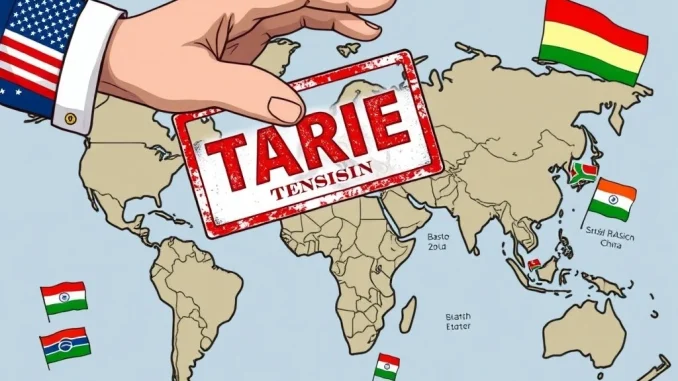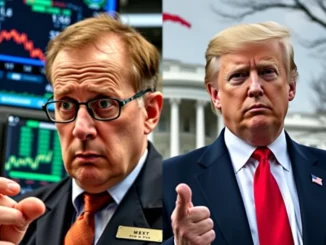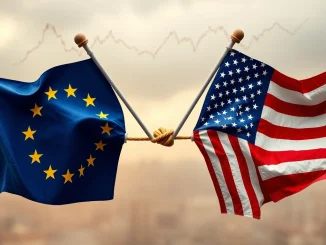
In the world of cryptocurrencies, staying informed about global economic and geopolitical events is crucial. Market sentiment and volatility can often be influenced by major policy shifts, and the latest announcement regarding US tariffs is certainly one such event warranting attention.
Understanding the Latest US Tariffs Announcement
According to former U.S. President Donald Trump on Truth Social, the United States is set to initiate a new phase of tariff implementation. Starting at 16:00 UTC on July 7, the U.S. government is scheduled to deliver tariff letters to countries worldwide. This move signals a significant step in reshaping international trade relations under potential future administrations.
While the initial announcement outlines a broad application of these new US tariffs, a specific detail stands out:
- Tariff letters delivered globally starting July 7, 16:00 UTC.
- An additional 10% tariff will be imposed on countries deemed to be supporting the anti-American policies of the BRICS group.
This targeted approach adds a layer of complexity, linking trade policy directly to geopolitical alignment.
What Are Trump Tariffs and Why the Focus on BRICS?
The term “Trump tariffs” often refers to protectionist trade measures implemented during his previous presidency, primarily aimed at reducing trade deficits and encouraging domestic production. These typically involved imposing taxes on imported goods, making them more expensive for domestic consumers and businesses, theoretically favoring domestically produced alternatives.
The specific mention of BRICS tariffs introduces a new dynamic. BRICS is an association of emerging economies, originally comprising Brazil, Russia, India, China, and South Africa, and has recently expanded to include other nations like Iran, Egypt, Ethiopia, and the UAE. The group often advocates for a multipolar world order and increased economic cooperation independent of traditional Western-led institutions.
Imposing an additional 10% tariff on countries supporting “anti-American policies” of BRICS appears to be a direct challenge to the group’s growing influence and an attempt to pressure nations into aligning more closely with U.S. foreign policy objectives. The definition of “anti-American policies” in this context remains open to interpretation, potentially leading to widespread uncertainty among trading partners.
Potential Trade War Impact: What Could Happen Next?
The implementation of new US tariffs, particularly those targeting a significant bloc like BRICS and its supporters, carries the potential for a notable trade war impact. A trade war occurs when countries retaliate against each other by imposing tariffs or quotas on imports. This escalation can lead to several negative consequences:
- Increased Costs: Tariffs are taxes on imports, which can lead to higher prices for consumers and businesses relying on imported goods.
- Supply Chain Disruption: Companies may need to find new suppliers or relocate production, leading to inefficiencies and delays.
- Reduced Exports: Retaliatory tariffs from other countries can make a nation’s exports more expensive, hurting domestic industries.
- Economic Slowdown: Trade wars can dampen business confidence, reduce investment, and slow overall economic growth.
The specific focus on BRICS could exacerbate existing geopolitical tensions and fragment global trade networks further.
Navigating the Ripple Effects on Global Trade and Markets
The announcement of new US tariffs and the targeted action against BRICS supporters will undoubtedly send ripples through global trade channels. Industries reliant on international trade, from manufacturing to agriculture, will need to assess potential impacts on costs, sourcing, and market access. Countries facing these tariffs may look to strengthen trade ties with non-U.S. partners or seek ways to circumvent the new barriers.
For those monitoring financial markets, including the volatile world of crypto assets, understanding these macro-level shifts is key. While the connection isn’t always direct, major disruptions to global trade and economic stability can influence investor sentiment, currency strength, inflation expectations, and overall market liquidity. Geopolitical tension, often heightened by trade disputes, can sometimes lead investors to seek perceived safe-haven assets, though the definition of ‘safe’ is constantly debated in the digital asset space.
Actionable Insight: Stay informed. While you don’t need to be a trade policy expert, understanding the potential economic headwinds and tailwinds created by these significant policy changes can provide valuable context for navigating financial markets. Keep an eye on how different countries react and the broader economic indicators that follow.
Summary: A New Chapter in Global Trade Relations?
The U.S. announcement of new US tariffs starting July 7, particularly the additional 10% levy targeting countries supporting BRICS’s “anti-American policies,” marks a potentially significant turning point in global trade relations. These Trump tariffs, if implemented, could trigger a notable trade war impact, disrupting supply chains, increasing costs, and potentially slowing economic growth worldwide. As the situation unfolds, market participants, including those in the crypto space, should monitor developments closely to understand the potential ripple effects on the broader global economy and financial markets.



